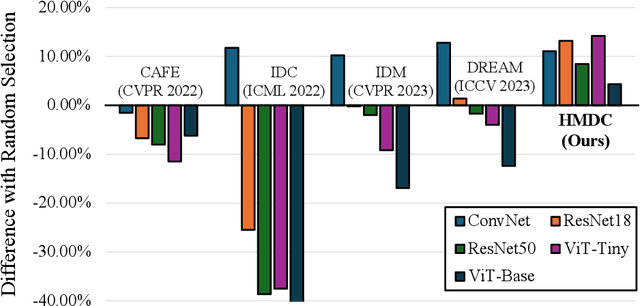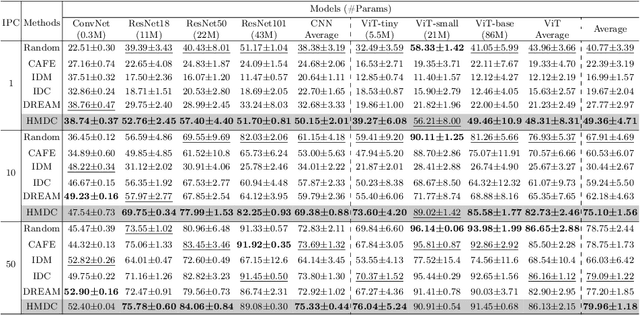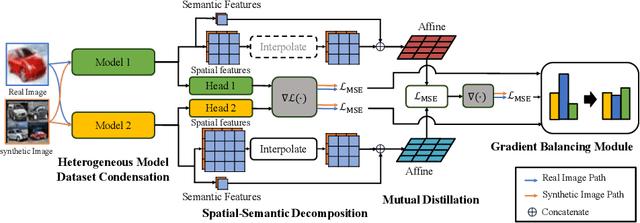Gyeong-Moon Park
Universal Domain Adaptation for Semantic Segmentation
May 28, 2025Abstract:Unsupervised domain adaptation for semantic segmentation (UDA-SS) aims to transfer knowledge from labeled source data to unlabeled target data. However, traditional UDA-SS methods assume that category settings between source and target domains are known, which is unrealistic in real-world scenarios. This leads to performance degradation if private classes exist. To address this limitation, we propose Universal Domain Adaptation for Semantic Segmentation (UniDA-SS), achieving robust adaptation even without prior knowledge of category settings. We define the problem in the UniDA-SS scenario as low confidence scores of common classes in the target domain, which leads to confusion with private classes. To solve this problem, we propose UniMAP: UniDA-SS with Image Matching and Prototype-based Distinction, a novel framework composed of two key components. First, Domain-Specific Prototype-based Distinction (DSPD) divides each class into two domain-specific prototypes, enabling finer separation of domain-specific features and enhancing the identification of common classes across domains. Second, Target-based Image Matching (TIM) selects a source image containing the most common-class pixels based on the target pseudo-label and pairs it in a batch to promote effective learning of common classes. We also introduce a new UniDA-SS benchmark and demonstrate through various experiments that UniMAP significantly outperforms baselines. The code is available at \href{https://github.com/KU-VGI/UniMAP}{this https URL}.
PCBEAR: Pose Concept Bottleneck for Explainable Action Recognition
Apr 17, 2025Abstract:Human action recognition (HAR) has achieved impressive results with deep learning models, but their decision-making process remains opaque due to their black-box nature. Ensuring interpretability is crucial, especially for real-world applications requiring transparency and accountability. Existing video XAI methods primarily rely on feature attribution or static textual concepts, both of which struggle to capture motion dynamics and temporal dependencies essential for action understanding. To address these challenges, we propose Pose Concept Bottleneck for Explainable Action Recognition (PCBEAR), a novel concept bottleneck framework that introduces human pose sequences as motion-aware, structured concepts for video action recognition. Unlike methods based on pixel-level features or static textual descriptions, PCBEAR leverages human skeleton poses, which focus solely on body movements, providing robust and interpretable explanations of motion dynamics. We define two types of pose-based concepts: static pose concepts for spatial configurations at individual frames, and dynamic pose concepts for motion patterns across multiple frames. To construct these concepts, PCBEAR applies clustering to video pose sequences, allowing for automatic discovery of meaningful concepts without manual annotation. We validate PCBEAR on KTH, Penn-Action, and HAA500, showing that it achieves high classification performance while offering interpretable, motion-driven explanations. Our method provides both strong predictive performance and human-understandable insights into the model's reasoning process, enabling test-time interventions for debugging and improving model behavior.
ESC: Erasing Space Concept for Knowledge Deletion
Apr 03, 2025Abstract:As concerns regarding privacy in deep learning continue to grow, individuals are increasingly apprehensive about the potential exploitation of their personal knowledge in trained models. Despite several research efforts to address this, they often fail to consider the real-world demand from users for complete knowledge erasure. Furthermore, our investigation reveals that existing methods have a risk of leaking personal knowledge through embedding features. To address these issues, we introduce a novel concept of Knowledge Deletion (KD), an advanced task that considers both concerns, and provides an appropriate metric, named Knowledge Retention score (KR), for assessing knowledge retention in feature space. To achieve this, we propose a novel training-free erasing approach named Erasing Space Concept (ESC), which restricts the important subspace for the forgetting knowledge by eliminating the relevant activations in the feature. In addition, we suggest ESC with Training (ESC-T), which uses a learnable mask to better balance the trade-off between forgetting and preserving knowledge in KD. Our extensive experiments on various datasets and models demonstrate that our proposed methods achieve the fastest and state-of-the-art performance. Notably, our methods are applicable to diverse forgetting scenarios, such as facial domain setting, demonstrating the generalizability of our methods. The code is available at http://github.com/KU-VGI/ESC .
Multispectral Pedestrian Detection with Sparsely Annotated Label
Jan 05, 2025



Abstract:Although existing Sparsely Annotated Object Detection (SAOD) approches have made progress in handling sparsely annotated environments in multispectral domain, where only some pedestrians are annotated, they still have the following limitations: (i) they lack considerations for improving the quality of pseudo-labels for missing annotations, and (ii) they rely on fixed ground truth annotations, which leads to learning only a limited range of pedestrian visual appearances in the multispectral domain. To address these issues, we propose a novel framework called Sparsely Annotated Multispectral Pedestrian Detection (SAMPD). For limitation (i), we introduce Multispectral Pedestrian-aware Adaptive Weight (MPAW) and Positive Pseudo-label Enhancement (PPE) module. Utilizing multispectral knowledge, these modules ensure the generation of high-quality pseudo-labels and enable effective learning by increasing weights for high-quality pseudo-labels based on modality characteristics. To address limitation (ii), we propose an Adaptive Pedestrian Retrieval Augmentation (APRA) module, which adaptively incorporates pedestrian patches from ground-truth and dynamically integrates high-quality pseudo-labels with the ground-truth, facilitating a more diverse learning pool of pedestrians. Extensive experimental results demonstrate that our SAMPD significantly enhances performance in sparsely annotated environments within the multispectral domain.
Towards High-fidelity Head Blending with Chroma Keying for Industrial Applications
Nov 01, 2024Abstract:We introduce an industrial Head Blending pipeline for the task of seamlessly integrating an actor's head onto a target body in digital content creation. The key challenge stems from discrepancies in head shape and hair structure, which lead to unnatural boundaries and blending artifacts. Existing methods treat foreground and background as a single task, resulting in suboptimal blending quality. To address this problem, we propose CHANGER, a novel pipeline that decouples background integration from foreground blending. By utilizing chroma keying for artifact-free background generation and introducing Head shape and long Hair augmentation ($H^2$ augmentation) to simulate a wide range of head shapes and hair styles, CHANGER improves generalization on innumerable various real-world cases. Furthermore, our Foreground Predictive Attention Transformer (FPAT) module enhances foreground blending by predicting and focusing on key head and body regions. Quantitative and qualitative evaluations on benchmark datasets demonstrate that our CHANGER outperforms state-of-the-art methods, delivering high-fidelity, industrial-grade results.
Towards Model-Agnostic Dataset Condensation by Heterogeneous Models
Sep 22, 2024



Abstract:Abstract. The advancement of deep learning has coincided with the proliferation of both models and available data. The surge in dataset sizes and the subsequent surge in computational requirements have led to the development of the Dataset Condensation (DC). While prior studies have delved into generating synthetic images through methods like distribution alignment and training trajectory tracking for more efficient model training, a significant challenge arises when employing these condensed images practically. Notably, these condensed images tend to be specific to particular models, constraining their versatility and practicality. In response to this limitation, we introduce a novel method, Heterogeneous Model Dataset Condensation (HMDC), designed to produce universally applicable condensed images through cross-model interactions. To address the issues of gradient magnitude difference and semantic distance in models when utilizing heterogeneous models, we propose the Gradient Balance Module (GBM) and Mutual Distillation (MD) with the SpatialSemantic Decomposition method. By balancing the contribution of each model and maintaining their semantic meaning closely, our approach overcomes the limitations associated with model-specific condensed images and enhances the broader utility. The source code is available in https://github.com/KHU-AGI/HMDC.
Versatile Incremental Learning: Towards Class and Domain-Agnostic Incremental Learning
Sep 17, 2024



Abstract:Incremental Learning (IL) aims to accumulate knowledge from sequential input tasks while overcoming catastrophic forgetting. Existing IL methods typically assume that an incoming task has only increments of classes or domains, referred to as Class IL (CIL) or Domain IL (DIL), respectively. In this work, we consider a more challenging and realistic but under-explored IL scenario, named Versatile Incremental Learning (VIL), in which a model has no prior of which of the classes or domains will increase in the next task. In the proposed VIL scenario, the model faces intra-class domain confusion and inter-domain class confusion, which makes the model fail to accumulate new knowledge without interference with learned knowledge. To address these issues, we propose a simple yet effective IL framework, named Incremental Classifier with Adaptation Shift cONtrol (ICON). Based on shifts of learnable modules, we design a novel regularization method called Cluster-based Adaptation Shift conTrol (CAST) to control the model to avoid confusion with the previously learned knowledge and thereby accumulate the new knowledge more effectively. Moreover, we introduce an Incremental Classifier (IC) which expands its output nodes to address the overwriting issue from different domains corresponding to a single class while maintaining the previous knowledge. We conducted extensive experiments on three benchmarks, showcasing the effectiveness of our method across all the scenarios, particularly in cases where the next task can be randomly altered. Our implementation code is available at https://github.com/KHU-AGI/VIL.
Online Continuous Generalized Category Discovery
Aug 24, 2024



Abstract:With the advancement of deep neural networks in computer vision, artificial intelligence (AI) is widely employed in real-world applications. However, AI still faces limitations in mimicking high-level human capabilities, such as novel category discovery, for practical use. While some methods utilizing offline continual learning have been proposed for novel category discovery, they neglect the continuity of data streams in real-world settings. In this work, we introduce Online Continuous Generalized Category Discovery (OCGCD), which considers the dynamic nature of data streams where data can be created and deleted in real time. Additionally, we propose a novel method, DEAN, Discovery via Energy guidance and feature AugmentatioN, which can discover novel categories in an online manner through energy-guided discovery and facilitate discriminative learning via energy-based contrastive loss. Furthermore, DEAN effectively pseudo-labels unlabeled data through variance-based feature augmentation. Experimental results demonstrate that our proposed DEAN achieves outstanding performance in proposed OCGCD scenario.
Open-Set Domain Adaptation for Semantic Segmentation
May 30, 2024



Abstract:Unsupervised domain adaptation (UDA) for semantic segmentation aims to transfer the pixel-wise knowledge from the labeled source domain to the unlabeled target domain. However, current UDA methods typically assume a shared label space between source and target, limiting their applicability in real-world scenarios where novel categories may emerge in the target domain. In this paper, we introduce Open-Set Domain Adaptation for Semantic Segmentation (OSDA-SS) for the first time, where the target domain includes unknown classes. We identify two major problems in the OSDA-SS scenario as follows: 1) the existing UDA methods struggle to predict the exact boundary of the unknown classes, and 2) they fail to accurately predict the shape of the unknown classes. To address these issues, we propose Boundary and Unknown Shape-Aware open-set domain adaptation, coined BUS. Our BUS can accurately discern the boundaries between known and unknown classes in a contrastive manner using a novel dilation-erosion-based contrastive loss. In addition, we propose OpenReMix, a new domain mixing augmentation method that guides our model to effectively learn domain and size-invariant features for improving the shape detection of the known and unknown classes. Through extensive experiments, we demonstrate that our proposed BUS effectively detects unknown classes in the challenging OSDA-SS scenario compared to the previous methods by a large margin. The code is available at https://github.com/KHU-AGI/BUS.
Generative Unlearning for Any Identity
May 16, 2024



Abstract:Recent advances in generative models trained on large-scale datasets have made it possible to synthesize high-quality samples across various domains. Moreover, the emergence of strong inversion networks enables not only a reconstruction of real-world images but also the modification of attributes through various editing methods. However, in certain domains related to privacy issues, e.g., human faces, advanced generative models along with strong inversion methods can lead to potential misuses. In this paper, we propose an essential yet under-explored task called generative identity unlearning, which steers the model not to generate an image of a specific identity. In the generative identity unlearning, we target the following objectives: (i) preventing the generation of images with a certain identity, and (ii) preserving the overall quality of the generative model. To satisfy these goals, we propose a novel framework, Generative Unlearning for Any Identity (GUIDE), which prevents the reconstruction of a specific identity by unlearning the generator with only a single image. GUIDE consists of two parts: (i) finding a target point for optimization that un-identifies the source latent code and (ii) novel loss functions that facilitate the unlearning procedure while less affecting the learned distribution. Our extensive experiments demonstrate that our proposed method achieves state-of-the-art performance in the generative machine unlearning task. The code is available at https://github.com/KHU-AGI/GUIDE.
 Add to Chrome
Add to Chrome Add to Firefox
Add to Firefox Add to Edge
Add to Edge